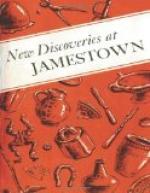Some of the structures encountered in the first explorations remain to be more fully excavated and recorded. Structures in this category total 23.
Miscellaneous Structures
Because of the inadequacy of Jamestown remains and records, it is difficult to determine the purposes for which the various outbuildings were used. Doubtless, many outbuildings did exist for various purposes, and probably most of them were not substantial enough to leave a trace. Two clearly isolated, small structures properly called outbuildings (discovered in 1955) are all that will be cited here. The first is the large double-chimney foundation just beyond the southwest corner of the mansion east of the museum. Undoubtedly this belonged to a detached kitchen. The second is a small, but thick-walled, rectangular structure of brick which may have been a food storehouse or even a powder magazine.
[Illustration: Although most Jamestown workshops were probably made of framework and were merely sheds, one brick foundation has three brick fireboxes and A large brick chimney. This structure was probably A Brew house, bakery, or distillery.]
Workshop Structures
Most of the early industries at Jamestown were undoubtedly housed in perishable wooden structures that have left the least evident traces, such as frame sheds for forges and wine presses, carpenters’ shops, and buildings used by various artisans and craftsmen. So far, only two industrial structures are clearly recognizable (aside from kilns), although their precise use is not certain.
One of these, on the edge of Pitch and Tar Swamp, was a nearly square, tile-floored workshop with a rough but substantial brick foundation supporting the framework of the walls. On the floor were 3 fireboxes, 2 of which were associated with a large chimney area. What was fabricated here has not yet been determined, although ceramic firing, brewing, distilling, and even ironworking, have been suggested. Proximity of pottery and lime-burning kilns, and a small pit where iron may have been smelted, may be significant.
A second, very fragmentary brick foundation close to the present riverbank suggests a shop rather than a house, but lacks firebox evidence or other identifying features. It may be 18th- rather than 17th-century.
[Illustration: Near the foundation of the probable Bake shop, A Pair of kilns once served for slaking lime, and perhaps for firing pottery. Between the kilns was A flame-scarred pit containing evidence of ironworking and the roasting of bog ore for iron.]




